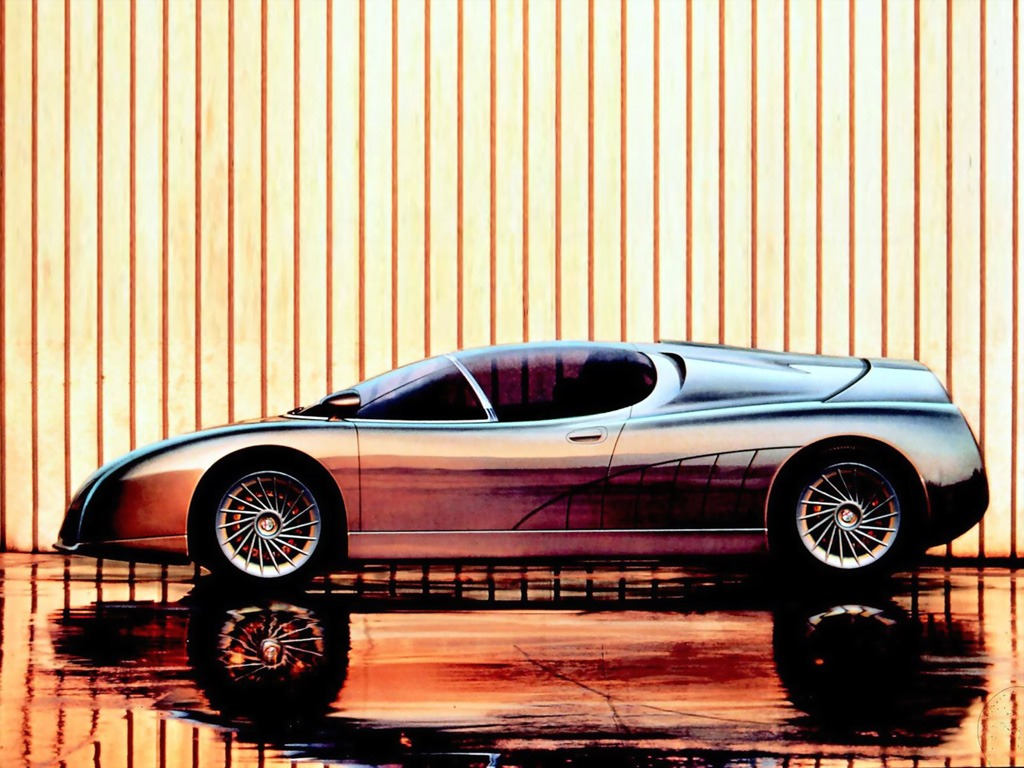Volkswagen W12 Coupe Concept (2001)
In 2001, Volkswagen rolled out an updated version of the W12 coupe. Now known as the Nardo, the orange car boasted a 6.0-liter W-12 good for 591 hp and 458 lb-ft of torque, and allegedly capable of 0-62 mph times of 3.5 seconds.
Its new name was fitting, as a modified W12 Nardo set a 24-hour endurance speed record at Italy’s Nardo test circuit, where it covered roughly 4810 miles at an average speed at just over 200 mph.
Bizzarrini Manta (1968)
Designed by Giugiaro in 1968, through his new company, ItalDesign, the Bizzarrini Manta was the company’s first project. The Manta was a concept car based on the tubular chassis of the Bizzarrini 538. The car featured a mid mounted Chevrolet V8 engine, producing 400bhp. The car was 1050mm high and 4100mm long and 1855mm wide.
Maserati Boomerang (1972)
Powered by a 4.7L V8 engine producing 310 hp (314 PS; 231 kW) and 460 N⋅m (339 lb⋅ft) driving the rear wheels, 5-speed manual transmission and having a fully decked out interior, it has a unique dashboard layout where the steering wheel and gauge cluster are part of a single console that emerges from the dash, and the steering wheel rotates around the stationary gauges.
Bugatti ID 90 (1990)
The Bugatti ID 90 concept was a 2-seat, mid-engine, all-wheel-drive supercar. Bugatti ID 90 was ItalDesign’s proposal for the Bugatti EB 110 supercar which debuted in 1991. The ID 90 and EB 110 share several similarities including a similar overall shape and many design elements. The styling of the Bugatti ID 90 was clean and purposeful with air intakes liberally positioned down the sides and alongside the rear windows to help feed and cool the massive engine sitting behind the 2-seat cockpit.
BMW Nazca C2 (1991)
In the early nineties, Italdesign was itching to enter the supercar market. The first prototype they completed was the Italdesign M12. This car featured a version of the V12 engine found in the BMW 750i and 850i. Giorgetto Giugiaro, Italdesign’s founder was responsible for the styling, and before the car went into production, he wanted to make it more radical.
In late 1991, Giugiaro restyled the M12 into the car that became known as the C2. The car was very similar to the M12 except the newer C2 featured an Alpina-tuned V12. This was the same unit found in the Alpina B12.
Sadly, the Nazca project never made it beyond the prototype phase. Three prototypes were made and are driven regularly. The last appearance of a C2 was at the 2002 Supercar Rally.
Alfa Romeo Iguana (1969)
The car was previewed at the Sport Car Show in Monza and presented officially at the Turin Auto Show in 1969. It was the first Alfa Romeo model designed by Giorgetto Giugiaro as head of his own carrozzeria, and was based on the Alfa Romeo 33 Stradale road-going version of the Tipo 33/2. Although it did not go into production, the Iguana is reflected in Giugiaro’s later work. The body of the Iguana was painted a metal-flake grey, while the roof frame and cabin pillars were finished in brushed metal, a treatment Giugiaro later applied to the DeLorean DMC-12.
Alfa Romeo Scighera (1997)
The Scighera, “mist” in Milanese dialect was a 1997 homage to Alfa’s glory and reputation on the track.
The bonnet arose directly from the grille shield and the extreme shape incorporated a spoiler derived from Formula 1 cars, emphasised by the brand-new ‘clown-eyed’ headlight motif.
The windscreen took its inspiration from cars of the 1950s and 1960s, with a chassis extending at the side without, however, affecting access to the car.
The window is lifted using a gull wing mechanism and can be removed for conversion to an open-topped car. The large bonnet and wing is in one piece and opens in two movements: the first allows refueling while the second allows access to the engine. The bonnet incorporates a window that allows a glimpse of the power unit.
The Scighera is fitted with a 3000 cc, 400 hp mid-longitudinal Alfa Romeo bi-turbo V6 engine and comes with permanent four-wheel drive.
Lamborghini Cala (1995)
The Calà, introduced at the Geneva motor show in 1995, is a research prototype for a 2+2 coupé that can be converted to an open-topped car similar to the Targa.
In stylistic terms, the car clearly displays the influence of conventional Lamborghini traits, namely Miura-derived front headlights and a windscreen reminiscent of the Countach.
The Calà is, however, significantly higher for reasons of comfort. The well-lit passenger compartment can in fact easily accommodate two adults and two children. The carbon fibre body is anchored to an aluminium chassis with the adoption of a brand-new technology involving folded, bonded panels.
The mechanical layout was designed by Lamborghini, with a new V10, 3961 cc, 372 HP, 7200 rpm engine fitted in a mid-rear position, combined with rear-wheel drive.






















































